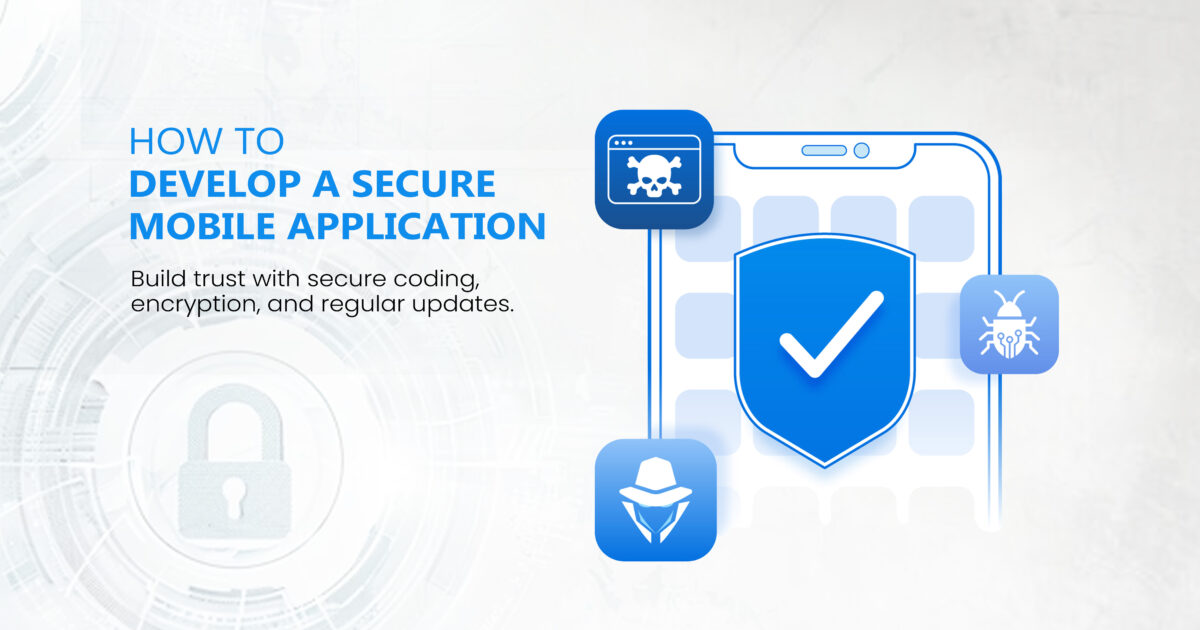The digital age has introduced mobile applications into nearly every aspect of our daily lives, from banking and shopping to healthcare and communication. However, with this convenience comes significant responsibility,ensuring these apps are secure. Mobile apps often handle sensitive personal and financial information, making them attractive targets for cybercriminals.
The importance of security in mobile applications cannot be overstated. Data breaches, malware attacks, and identity theft are just a few risks that arise from poorly secured apps. For developers, this is not just a technical challenge, it is a matter of trust. Users expect their data to remain private, and a failure to meet this expectation can damage a brand’s reputation and lead to costly legal repercussions.
This blog serves as a step-by-step guide for developers seeking to prioritize security in their mobile applications. From planning and authentication to testing and compliance, we will cover the critical elements needed to create apps that are not just functional but also secure.
Understanding Security in Mobile Applications
Mobile applications face unique challenges compared to other software. The combination of diverse operating systems, extensive user bases, and evolving cyber threats makes security in mobile app development both critical and complex.
One of the most common threats is insecure data storage, where sensitive information is stored in plaintext or unprotected formats. Weak server-side controls also expose backend systems to attacks like SQL injection or unauthorized access. Additionally, inadequate authentication mechanisms make it easier for attackers to hijack user accounts or steal data.
Statistics reveal the rising need for secure apps. For instance, reports indicate that 43% of cyberattacks target small businesses, many of which rely on mobile apps for customer interactions. These numbers underscore the urgency of adopting robust security measures in app development to safeguard user data and maintain trust.
Steps to Develop a Secure Mobile Application
A: Planning the Security Architecture
The foundation of a secure mobile app lies in its architecture. Planning this architecture ensures that security measures are embedded into the app’s core functionality, reducing risks from the outset.
Effective security architecture begins with a thorough risk assessment, where developers identify potential vulnerabilities and assess their impact. For instance, apps handling financial transactions should prioritize secure data storage and transmission. Threat modeling can further refine this process, offering a roadmap for mitigating risks.
Equally important is selecting secure coding frameworks and platforms. Frameworks like React Native and Flutter offer built-in security features that help developers avoid common pitfalls. By using proven technologies, developers can focus on building secure functionality without reinventing the wheel.
Conducting a Risk Assessment
Risk assessments are pivotal in identifying potential weak points in your app. This process involves evaluating data flow, understanding attack vectors, and pinpointing the areas that require fortification. For example, apps handling payment details must prioritize end-to-end encryption and secure API usage to prevent interception or tampering.
Selecting Secure Coding Frameworks
Secure frameworks streamline development while providing robust protection. These frameworks often include libraries for encryption, authentication, and API security. For instance, frameworks like Angular or Vue.js simplify secure coding practices, helping developers avoid vulnerabilities such as cross-site scripting (XSS) or injection attacks.
B.Secure Authentication and Authorization
Authentication and authorization processes determine how users interact with your app while ensuring data remains accessible only to authorized personnel. Strong authentication mechanisms are essential to prevent unauthorized access and data breaches.
Implementing Multi-Factor Authentication (MFA)
MFA adds a critical layer of security by requiring users to verify their identity through multiple factors, such as passwords, OTPs, or biometrics. By implementing MFA, apps significantly reduce the risk of unauthorized access, even if one layer of security is compromised.
Role-Based Access Control (RBAC)
RBAC ensures that users can only access the information and features that are relevant to their responsibilities.. For instance, administrators may require access to sensitive app settings, while regular users only access their own profiles. Internal threats are reduced as a result.
C. Data Protection and Encryption
Data protection is crucial in preventing sensitive information from being exposed. Encryption transforms data into unreadable formats, ensuring that even if intercepted, the data remains useless to attackers.
End-to-End Encryption
End-to-end encryption ensures that data is encrypted during transmission and can only be decrypted by the intended recipient. Protocols like SSL/TLS are commonly used to secure this process, protecting user communications from eavesdropping.
Secure Data Storage
Sensitive data stored on devices must be encrypted to prevent unauthorized access. Using encrypted databases or keychains ensures that even if the device is compromised, the data remains protected.
D. Writing Secure Code
Developing secure mobile applications begins with writing code that is free from vulnerabilities. Secure coding practices involve proactively identifying risks during development and implementing safeguards to protect the application from exploitation.
Avoiding Hard-Coded Credentials
Hard-coding sensitive information like API keys or passwords is a significant security risk. Attackers can quickly retrieve these credentials if they manage to access the source code of your application. Instead, developers should use secure storage mechanisms, such as environment variables or encrypted keychains, to store sensitive information.
Protecting Against Common Vulnerabilities
Writing secure code also means protecting against prevalent vulnerabilities like SQL Injection, Cross-Site Scripting (XSS), and Cross-Site Request Forgery (CSRF). For example, validating user inputs and sanitizing data can prevent injection attacks, while secure frameworks can help mitigate other common issues.
E. Testing and Monitoring
Testing and monitoring are critical to ensuring that your app remains secure throughout its lifecycle. Regularly assessing your app’s security helps identify vulnerabilities and ensures compliance with security standards.
Penetration Testing
Penetration testing simulates real-world attacks on your app to uncover vulnerabilities before malicious actors exploit them. These tests focus on areas such as user authentication, data storage, and API endpoints, allowing developers to address weaknesses proactively.
Continuous Monitoring and Logging
Monitoring your app in real-time allows you to detect unusual activity or potential threats. Implementing detailed logging ensures that incidents are documented and can be analyzed to improve security measures over time.
F. Compliance with Regulations
Ensuring compliance with data protection laws and industry standards is a critical component of mobile app security. Regulations like GDPR and CCPA dictate how user data should be handled and stored, making adherence essential.
Adhering to GDPR and CCPA
Both GDPR and CCPA emphasize user privacy and the secure handling of personal data. Developers must implement features like consent forms and data deletion options to meet these standards and avoid legal penalties.
Following OWASP Guidelines
The OWASP Mobile Security Project provides comprehensive guidelines for secure app development. Following these best practices helps protect apps against the most critical threats and ensures robust security.
G. Secure APIs
APIs are often the backbone of mobile applications, facilitating communication between the app and external services. However, improperly secured APIs can expose your app to significant risks.
Using API Gateways
API gateways act as intermediaries that secure communication between the app and external services. They offer features like authentication, rate limiting, and data encryption to enhance security.
Input Validation and Rate Limiting
Validating user input ensures that data sent through APIs is free from malicious code, preventing attacks like injection. Similarly, rate limiting helps mitigate denial-of-service (DoS) attacks by restricting the number of requests a user can make in a given timeframe.
H. Regular Updates and Patching
Regular updates and patching are essential to keeping your app secure against new threats. Cybercriminals constantly develop new attack methods, making it vital to stay one step ahead.
Keeping Libraries and Frameworks Up-to-Date
Using outdated libraries or frameworks leaves your app vulnerable to exploits. Developers must monitor for updates and apply patches promptly to address known vulnerabilities.
Automating Update Rollouts
Automating the update process ensures that patches are deployed quickly without manual intervention. This minimizes the window of opportunity for attackers and keeps users protected.
Tools and Technologies for Secure App Development
Leveraging the right tools and technologies simplifies secure app development and ensures compliance with security standards. These tools help identify vulnerabilities, secure data, and manage APIs efficiently.
Code Scanning Tools
Tools like SonarQube and Checkmarx automatically scan your code for vulnerabilities. They provide actionable insights, allowing developers to address issues early in the development process.
Encryption Libraries
Encryption libraries like Bouncy Castle and Libsodium provide robust solutions for securing data. These libraries make implementing advanced encryption techniques easier, even for less experienced developers.
API Security Platforms
Platforms like Postman and Apigee help secure APIs by offering features like authentication, encryption, and detailed monitoring. These tools simplify managing APIs and ensure secure communication.
Challenges in Developing Secure Mobile Apps
Developing secure mobile applications is not without its challenges. From balancing user experience to managing costs, developers must navigate several hurdles to achieve robust security.
Balancing Security and User Experience
While security is critical, overly complex processes can frustrate users. Striking a balance between usability and protection is essential for app adoption and success.
Platform-Specific Challenges
iOS and Android have unique security requirements and limitations. Developers must tailor their approaches to address these platform-specific challenges effectively.
Best Practices for Long-Term Security
Maintaining app security is an ongoing effort. Adopting best practices ensures that your app remains resilient to new threats over time.
User Education
Educating users about secure practices, such as recognizing phishing attempts, strengthens overall app security. Empowered users become the first line of defense against attacks.
Periodic Security Audits
Regular audits by third-party security experts help identify vulnerabilities that may have been overlooked. These audits ensure continued compliance with security standards and bolster user confidence.
Conclusion
Developing a secure mobile application is not just a technical necessity but a fundamental responsibility. By following the outlined steps and best practices, developers can create apps that inspire user trust and withstand evolving cyber threats. Remember, security is not a one-time effort but an ongoing commitment. Start with security in mind from day one, and your app will be better equipped to protect its users and thrive in the digital landscape.




